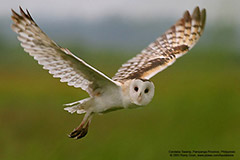What Is Biodiversity? The Owls Have It
|
Photo by: Romy Ocon
|
Professor Nigel Peake observes: ‘They’ve done this for millions of years before we ever thought of it.’ The good professor, although he does not make the specific connection in his statement, is referring to just one aspect of biodiversity and how it helps humans do more with less by observing how Mother Nature (biodiversity) has all the answers if we can just keep her alive long enough to show us. The article, in which owls and biodiversity are the object, was focused on improving the design of aircraft and wind-turbines.
The subject in this particular professor’s case is the study of owls and how their unique perfection of evolutionary wing design allows them to fly silently and more efficiently in pursuit of their prey than almost all other birds. The Wright brothers may have perfected powered flight but what has followed has not been a perfection of flight, not in the way that owls have perfected stealth flying, it has been more an exercise is developing one aspect of it: to go faster.
Here in the Philippines we have almost one unique owl species for each remote island of any size: the Bohol scops owl, the Camiguin Scops owl, the Sibuyan scops owl. To name but three that occur on islands within a few score miles of each other. In the distant past all scops owls found in the Philippines were lumped into one classification but many are now known to be distinct species – distinct because they needed to survive in different environments.
I saw my first owl in the Philippines one morning in 2010, as my flight from Davao City to Metro Manila was taxiing to the end of the runway.
Beautiful, elegant, majestic the owl looked for all the world like a barn owl (Tyto alba), so familiar to me from my native Somerset (England), as it gracefully flapped its wings, flying low and purposefully over the tall, un-mown grass, that divides the runway from the taxiways at Davao International Airport. It was bathed in the luxuriant essence of morning air, drenched with color by the barely risen sun. By its similar size, shape and color, it was probably an Australasian Grass-Owl (Tyto longimembris); with only a fleeting glimpse, through the condensation on an airplane window, it was not possible to be sure.
Since that time I have heard, rather than been privileged to see, many owls, in the still forested portions of the Philippines, as I have explored the more remote areas of this magnificent archipelago. The more I explore the more I come to believe that all of the answers to Man’s ambitions, as well as his sufferings, are just a footstep or a hand-grasp away . . . most of us are simply too blind to see.
Islands you have probably only heard of before in passing conversations – Sibuyan, Sibale, Romblon, Camiguin, Siargao and so many hundreds more – hold the secrets to what ails Man, in abundance. Whether it is cures for insect bites or cures for cancer, whether it is tools for survival or the clues to perfecting technological advances, the biodiversity of the Philippines is exceptional in its ability to deliver the goods.
Local people, I mean people who are descended from generations that have survived without outside assistance, know many of the secrets and are surprisingly happy to share them once they know that you are interested to learn.
The plants, the animals and the birds and many of Mother Nature’s idiosyncrasies are known to, and used by, the local people on their daily lives. Some of the idiosyncrasies are novelties while some are functional, some require an inquiring mind from outside to understand their significance.
I can show you novelty in the seeds from a mangrove growing on Sibale Island that are so exquisitely dissimilar to each other that you may work for days to put the seeds back in the configuration of the seed pods from which they came. I can show you a plant so small that one touch of its sap has the power to stop the pain from the largest insect bite. I can do this, the locals can do a hundred times more . . . if you take the time to seek their knowledge and open your mind to that which frequently seems counter-intuitive to the modern-educated mind.
Professor Peake has observed owls for many years before he had sufficient knowledge of the owl’s unique survival skills to even contemplate emulating them. Owls occupy just one tiny corner in the truly infinite realm of biodiversity that is present on our planet. If you can take the time away from your truly dumb smartphone and apply your brain to exploring the questions that are most pressing in our 21st century then you will discover some of the secrets from Mother Nature’s millions of centuries of experimentation, and learn something that does not promote money or fame or influence but just promotes future survival . . . the future survival of Man.
Come to the Philippines and take the path less trodden; and, learn of the uniqueness that is biodiversity, as Mother Nature understands it . . . and promotes it every day. Your own future survival may depend on what you learn here . . .



 Australasian Grass Owl (Tyto longimembris) in the Philippines
Australasian Grass Owl (Tyto longimembris) in the Philippines